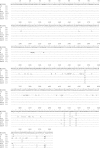Various penA mutations together with mtrR, porB and ponA mutations in Neisseria gonorrhoeae isolates with reduced susceptibility to cefixime or ceftriaxone
- PMID: 20093260
- PMCID: PMC2837549
- DOI: 10.1093/jac/dkp505
Various penA mutations together with mtrR, porB and ponA mutations in Neisseria gonorrhoeae isolates with reduced susceptibility to cefixime or ceftriaxone
Abstract
Objectives: To examine mutations within the penA, mtrR, porB, ponA and pilQ genes of Neisseria gonorrhoeae to determine their contribution to cephalosporin resistance.
Methods: A total of 46 N. gonorrhoeae isolates with reduced susceptibility to cefixime or ceftriaxone (MICs > or = 0.12 mg/L) and two susceptible isolates were selected. The full sequence of penA and partial sequences previously reported as hot mutation sites of the other genes were analysed. Genotyping by N. gonorrhoeae multiantigen sequence typing (NG-MAST) was also performed.
Results: A mosaic penicillin-binding protein 2 (PBP 2) was found in a single isolate that exhibited the highest cefixime MIC (0.5 mg/L). The majority of the isolates with reduced susceptibility to cephalosporins contained non-mosaic PBP 2 sequences, of which PBP 2 pattern XIII was most common (28/46). All isolates with reduced susceptibility to cephalosporins also had mtrR and porB mutations. Two susceptible isolates had the PBP 2 pattern XIV and an incomplete MtrR protein, which was a new mutation. Isolates with identical PBP 2 patterns comprised multiple NG-MAST sequence types.
Conclusions: Reduced susceptibility of N. gonorrhoeae to ceftriaxone and cefixime was associated with diverse penA mutations, particularly PBP 2 pattern XIII containing an Ala-501-->Val substitution, together with mtrR and porB mutations. The existence of only one strain having the mosaic penA sequence indicated that ceftriaxone and cefixime resistance in Korea is mostly not associated with a mosaic penA sequence. Highly heterogeneous NG-MAST sequence types excluded the clonal expansion of a particular subtype.
Figures

References
-
- Tapsall J. Antibiotic resistance in Neisseria gonorrhoeae is diminishing available treatment options for gonorrhea: some possible remedies. Expert Rev Anti Infect Ther. 2006;4:619–28. - PubMed
-
- Centers for Disease Control and Prevention (CDC) Update to CDC's sexually transmitted diseases treatment guidelines, 2006: fluoroquinolones no longer recommended for treatment of gonococcal infections. MMWR Morb Mortal Wkly Rep. 2007;56:332–6. - PubMed
-
- Australian Gonococcal Surveillance Programme. Annual report of the Australian Gonococcal Surveillance Programme. Commun Dis Intell 2006. 2005;30:205–10. - PubMed
Publication types
MeSH terms
Substances
Associated data
- Actions
- Actions
- Actions
LinkOut - more resources
Full Text Sources
Other Literature Sources
Medical
Molecular Biology Databases
Research Materials
Miscellaneous

